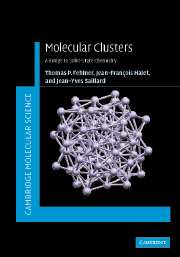Book contents
- Frontmatter
- Contents
- Preface
- 1 Introduction
- 2 Main-group clusters: geometric and electronic structure
- 3 Transition-metal clusters: geometric and electronic structure
- 4 Isolobal relationships between main-group and transition-metal fragments. Connections to organometallic chemistry
- 5 Main-group–transition-metal clusters
- 6 Transition to the solid state
- 7 From molecules to extended solids
- 8 Inter-conversion of clusters and solid-state materials
- Appendix: Fundamental concepts: a concise review
- Problem Answers
- References
- Index
- References
7 - From molecules to extended solids
Published online by Cambridge University Press: 19 February 2010
- Frontmatter
- Contents
- Preface
- 1 Introduction
- 2 Main-group clusters: geometric and electronic structure
- 3 Transition-metal clusters: geometric and electronic structure
- 4 Isolobal relationships between main-group and transition-metal fragments. Connections to organometallic chemistry
- 5 Main-group–transition-metal clusters
- 6 Transition to the solid state
- 7 From molecules to extended solids
- 8 Inter-conversion of clusters and solid-state materials
- Appendix: Fundamental concepts: a concise review
- Problem Answers
- References
- Index
- References
Summary
Of the millions of different chemical systems discovered since chemistry began, many are solids at room temperature. From the early days these solids have been classified in the four families, molecular, ionic, covalent and metallic solids, based on the nature of the forces which bind the atoms. Molecular solids are composed of groups of covalently bound atoms, i.e., molecules, held by weak charge-polarization (van der Waals) forces. In ionic solids, electrostatic attraction is the primary force binding cations and anions. Bonding in covalent solids is similar to that within molecules but extends over the whole crystallite. Metallic solids also exhibit extended bonding but, in addition, possess weakly bound, highly delocalized electrons easily moved by applied fields. Of course, this classification is somewhat artificial and many solids exhibit complex bonding in which more than one type of bonding is displayed. Molecular clusters in the solid state are naturally described nowadays with molecular-orbital models. Intermolecular interactions are weak. Although this is not true for solids with extended bonding networks, the solid-state machinery we developed in Chapter 6 shows that MO ideas smoothly transfer to crystalline solids. Hence, we have an analogous language for treating these more complex structures.
This is not a text of solid-state chemistry and the purpose of this chapter is to illustrate the use of the theoretical model of Chapter 6 with experimental examples. In doing so, we firmly establish the other foundation of our cluster bridge.
- Type
- Chapter
- Information
- Molecular ClustersA Bridge to Solid-State Chemistry, pp. 257 - 302Publisher: Cambridge University PressPrint publication year: 2007
References
- 1
- Cited by



